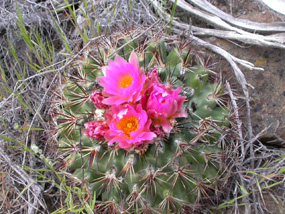 |
| Seeing a hedgehog cactus in bloom is a rare and thrilling sight. |
 |
World renowned for its collections of fossilized seeds, leaves, and wood, the John Day Fossil Beds National Monument also features a unique collection of present day flowers, cacti, and plants that have adapted to the exposed fossil bearing layers, volcanic outcroppings, and steep, rugged terrain found in the semi-arid environment.
Many a visitor has come to see the wildflowers in bloom at the Painted Hills Unit. Chaenactis and bee plants put on a flowery show in May against the orange and red backdrop of the exposed hillsides. Hedgehog cacti add their pink flowers to the show in the rocky outcroppings and drainages.
50 to 200 year old juniper trees are scattered around the hills with sagebrush, shadscale, and mountain mahogany comprising the bulk of the shrub community.
Bluebunch wheatgrass, Idaho fescue, indian ricegrass, and needle and thread make up only a few of the many grasses that protect the soils from erosion and provide food for wildlife.
Two Research Natural Areas have been designated within the Sheep Rock Unit to protect nearly pristine plant communities once common to the region. The entire monument is fenced and some areas have not had livestock grazing for over 25 years.
The monument is making a strong effort to restore the natural process of fire. This allows the plant communities to continue to thrive under conditions similar to those that existed prior to the influx of European man into the region 150 years ago.
The John Day River and two of its tributaries, Rock Creek and Bridge Creek, meander through the monument. They provide critically important riparian habitats for the birds, fish and mammals using these corridors. Cottonwood, willows, and alder provide shade to the river and nesting and roost sites for raptors and songbirds.
Sedges line the river edge along with rushes and reed canarygrass to provide important bank protection and cover for fish, rodents, and other wildlife. This riparian zone may be a few feet wide to several yards wide with many of the plants sending their roots down several feet to draw from the subsurface flows associated with the river during the hot summers.
| 





